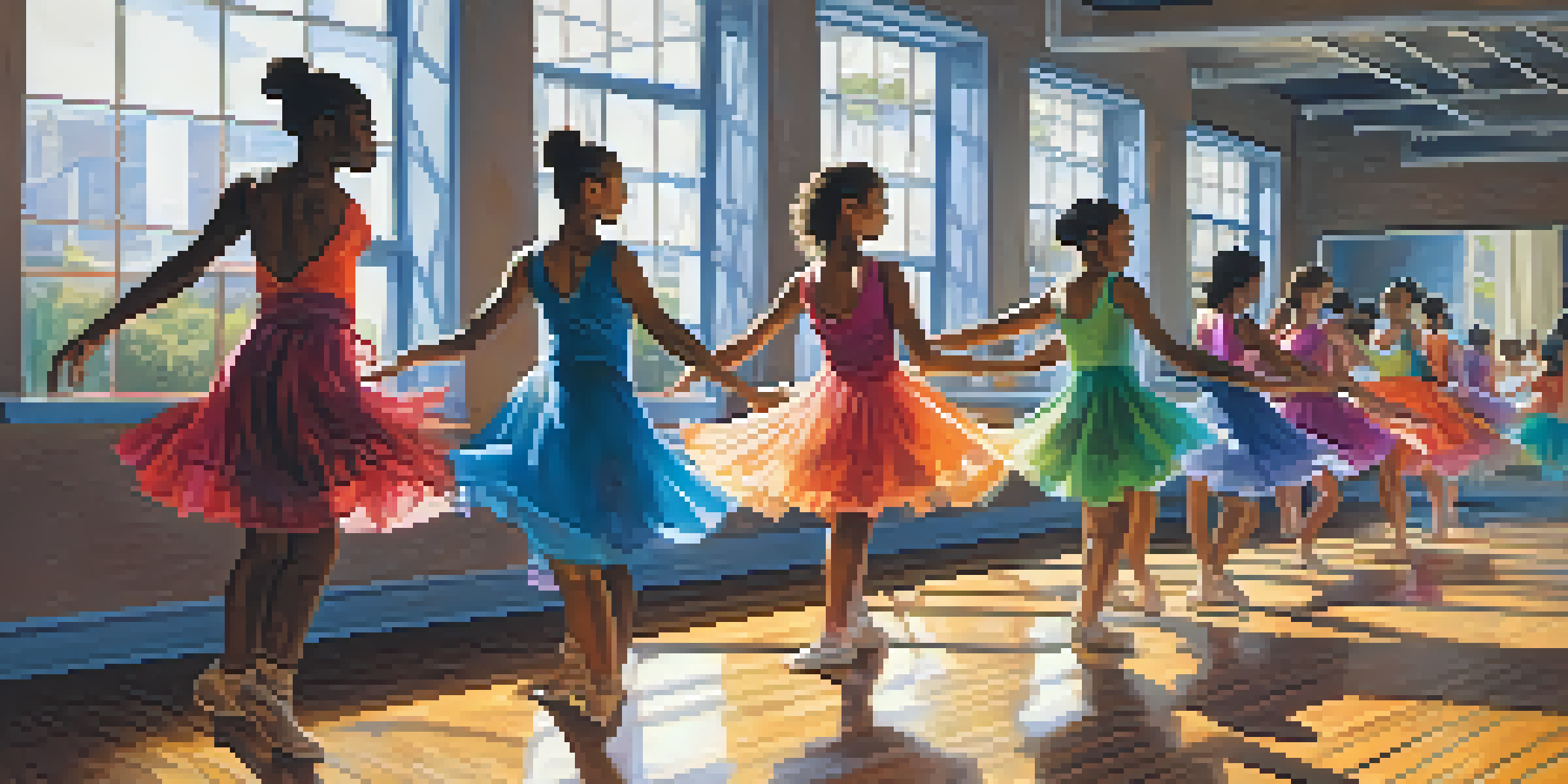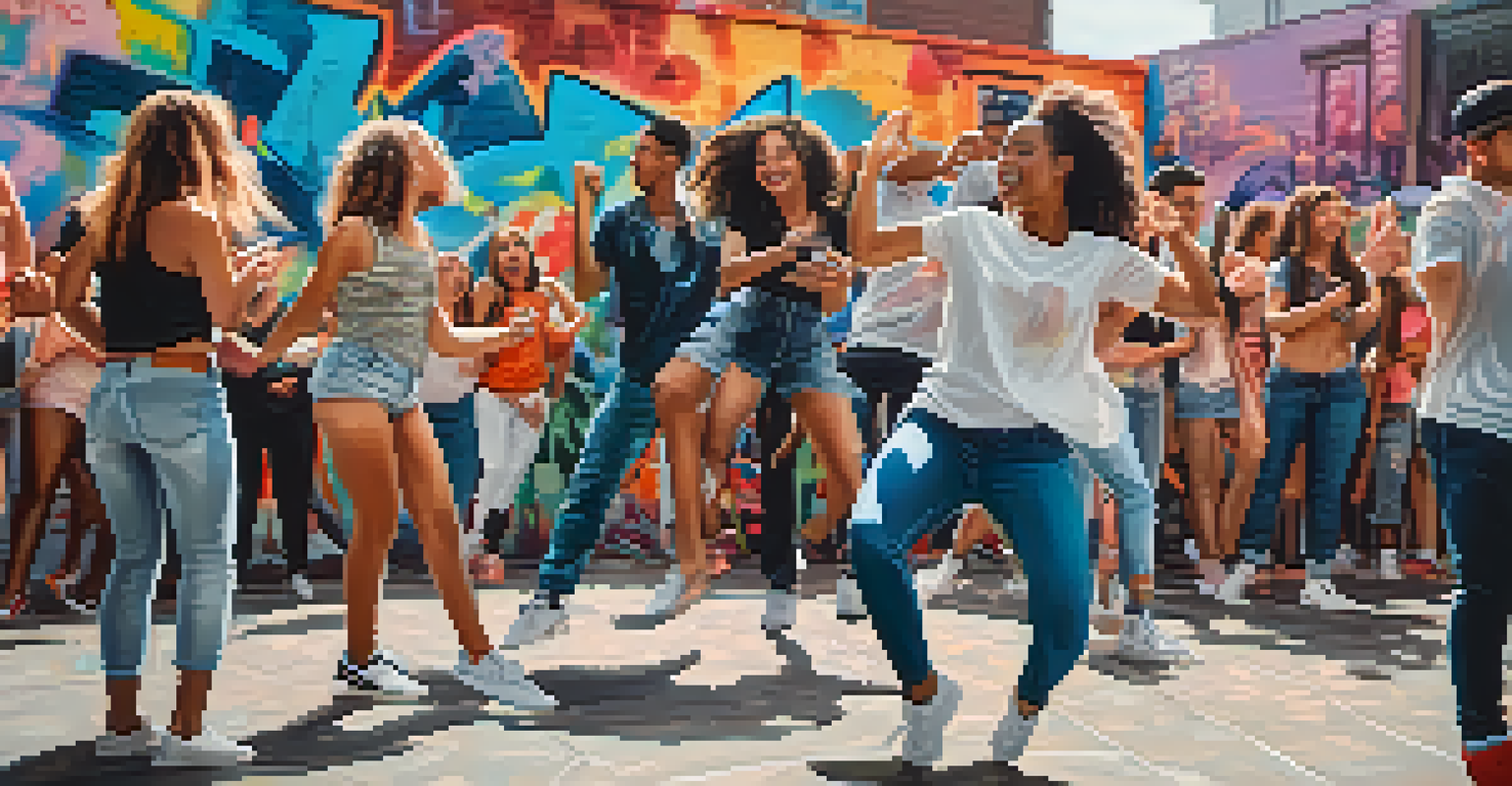Social Media's Role in Promoting Dance Collaborations Today

The Rise of Social Media in Dance Culture
In today’s digital age, social media has become a significant platform for dance enthusiasts. From Instagram to TikTok, dancers are using these channels to share their art and connect with a global audience. This accessibility has transformed the way dance is perceived, making it a vibrant part of contemporary culture.
Dance is the hidden language of the soul.
Not only are professional dancers showcasing their talents, but amateurs are also joining the conversation, creating a diverse tapestry of styles and influences. This democratization of dance allows anyone with a smartphone to share their moves and inspire others. The result? A flourishing community that celebrates creativity and collaboration.
Moreover, social media provides a unique opportunity for dancers to engage with one another, regardless of geographical boundaries. Dancers can now easily find collaborators, leading to innovative partnerships that might not have been possible before. This interconnectedness is reshaping the landscape of dance collaborations.
Connecting Dancers Across the Globe
One of the most remarkable aspects of social media is its ability to connect dancers from different corners of the world. For instance, a dancer in New York can collaborate with someone in Tokyo, sharing their styles and techniques in real-time. This instant connection fosters a rich exchange of ideas and movements.

Hashtags play a crucial role in this global network, enabling dancers to discover one another easily. By using tags like #dancechallenge or #collaboration, budding artists can find others who share their interests or styles. This not only promotes individual dancers but also builds a sense of community among diverse cultures.
Social Media Transforms Dance Culture
Platforms like Instagram and TikTok have democratized dance, allowing both professionals and amateurs to share their art and connect globally.
Additionally, social media platforms often host challenges, encouraging dancers to create and share content together. This sense of friendly competition can spark creativity and push artists to experiment with new forms and styles, leading to exciting collaborations that captivate audiences.
The Power of Viral Dance Trends
Viral dance trends have become a cultural phenomenon, largely driven by social media platforms. These trends often explode overnight, with millions joining in to replicate popular choreography. Such trends not only entertain but also create a shared experience for dancers worldwide.
Social media is about the people! Not about your business. Provide for the people and the people will provide for you.
When a dance challenge goes viral, it invites collaboration on a massive scale. Dancers can put their unique spins on the original choreography, encouraging creativity while promoting the original artist. This ripple effect can lead to new partnerships and collaborations, as dancers come together to remix and innovate.
Moreover, these trends often bring attention to lesser-known dancers or styles, providing them with a platform to showcase their talent. In this way, social media not only amplifies popular dance movements but also champions diversity within the dance community.
Creating Collaborative Content with Ease
Social media makes it easier than ever for dancers to collaborate and create content together. Platforms like Instagram and TikTok offer features that allow artists to stitch together videos, creating seamless dances that showcase each participant. This functionality encourages imaginative collaborations and interaction between dancers.
For example, two dancers can film their parts separately in different locations and then merge their clips into a single video. This creative flexibility allows for unique storytelling that can resonate with audiences, enhancing the collaborative experience. The result is often a compelling piece of art that highlights the strengths of each dancer.
Global Collaboration among Dancers
Social media enables dancers from different parts of the world to collaborate easily, fostering a vibrant exchange of styles and techniques.
Furthermore, dancers can provide feedback and ideas in real-time, fostering an environment of creativity and spontaneity. This collaborative spirit is essential for pushing artistic boundaries and developing new techniques and styles.
Building a Personal Brand through Collaboration
Social media not only facilitates collaboration but also helps dancers build their personal brands. By working with different partners and participating in collaborative projects, dancers gain exposure to new audiences. This visibility can be crucial for their careers, as it opens doors to opportunities such as sponsorships and performances.
Moreover, showcasing collaborations on social platforms can enhance a dancer's credibility and reputation within the community. It signals to followers that they are active participants in the dance world, constantly seeking new experiences and creative outlets. This proactive approach encourages followers to engage and support their journeys.
As dancers create unique content through collaborations, they can also develop a distinct voice and style that resonates with their audience. This authenticity is key to building a loyal fan base, as followers appreciate genuine artistic expression and frequently return for more.
Challenges of Collaborating in the Digital Age
While social media has opened countless doors for collaboration, it also presents challenges. With so many dancers vying for attention, it can be difficult to stand out in a crowded digital landscape. Dancers must continually innovate and adapt their styles to capture and maintain audience interest.
Additionally, the nature of online collaboration can sometimes lead to misunderstandings or miscommunication. Without face-to-face interaction, nuances in choreography or artistic intent may be lost. Dancers must be clear and intentional in their communication to ensure their collaborative efforts align.
Challenges in Digital Dance Collaboration
While online collaboration offers new opportunities, it also presents challenges like miscommunication and the pressure to produce viral content.
Finally, the pressure to produce viral content can overshadow the artistic process. Dancers may feel compelled to prioritize trends over genuine self-expression, which can lead to burnout or dissatisfaction with their craft. Finding a balance between creativity and audience engagement is crucial for sustaining a fulfilling dance career.
The Future of Dance Collaborations on Social Media
As technology continues to evolve, the future of dance collaborations on social media looks promising. Virtual reality and augmented reality are beginning to enter the dance scene, allowing for immersive experiences that can unite dancers in new and exciting ways. This could revolutionize how collaborations are conceived and executed.
Moreover, the rise of platforms dedicated to dance content is creating more opportunities for artists to showcase their work. These platforms not only promote collaboration but also provide dancers with tools to enhance their craft, from tutorials to networking opportunities.

Ultimately, social media will continue to play a pivotal role in shaping the dance landscape. As new generations of dancers embrace these platforms, the potential for innovative collaborations and cross-cultural exchanges will only grow, enriching the global dance community for years to come.